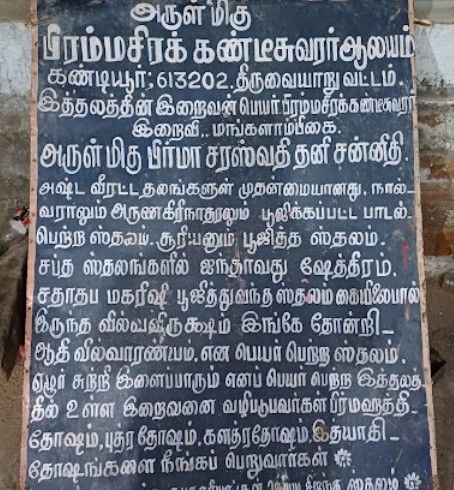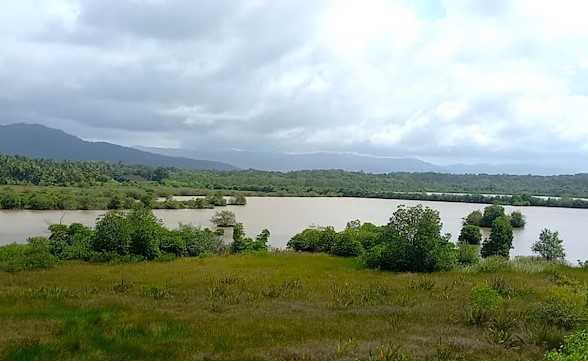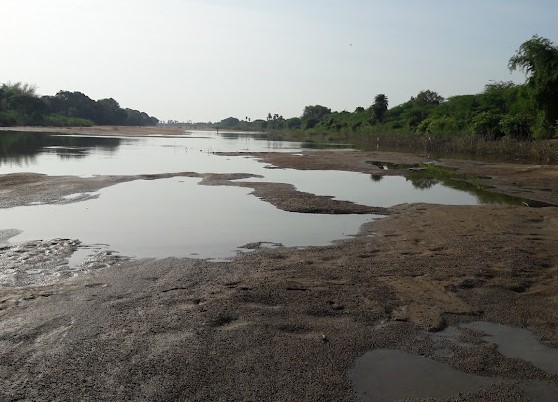The Brahma Sira Kandeeswarar Temple in Thirukkandiyur, near Tiruvaiyaru in Tamil Nadu, is a revered Hindu temple dedicated to Lord Shiva. It holds a significant place in the spiritual landscape, as it is celebrated through the hymns of Thirugnana Sambandar and is classified as a Paadal Petra Sthalam. This temple is one of the 276 Devara Paadal Petra Shiva Sthalams and is notably the 12th Shiva Sthalam situated on the southern bank of the Cauvery River in the Chozha Nadu region.
The presiding deity, Lord Shiva, is enshrined as a Swayambumurthi, meaning he is self-manifested. Additionally, this temple is recognized as the first among the eight Veerattana Sthalams and is part of the Sapthasthanam temple group of Thiruvaiyaru.
Architecturally, the temple faces west and features two corridors, with its majestic main tower, or Rajagopuram, boasting five tiers. The temple's rich history and divine significance continue to draw devotees and tourists alike.
PURANIC SIGNIFICANCE 1:

As per Hindu legend, Brahma, the Hindu god of creation and Shiva, the Hindu god of destruction, originally had five heads. Parvathi, the wife of Shiva once got confused and performed Patha Pooja (ablution of feet, considered an act of respect) to Brahma instead of Shiva. Shiva got enraged and cut off one of the heads of Brahma. The cut head got stuck in his hand of Shiva on account of a curse of Brahma. To get rid of the sin, Shiva worshipped Vishnu at Thirukarambanur as Bhikshadana, where a part of his sin was relieved. He got his curse fully relieved after visiting Vishnu at Thirukkandiyur and taking a holy dip in the temple tank, Kamala Pushkarani. Since Vishnu relieved (Vimochana) the sin (saabha) of Shiva (also called Hara), the temple is called Hara Saabha Vimochana Temple. After the incident, the tank came to be known as Kapala Theertham (kapala indicates skull). Shiva was pleased and he built the Hara Sabha Vimochana temple and also built a temple for himself near it.
PURANIC SIGNIFICANCE 2:
- As per another legend, Lakshmi, the consort of Vishnu requested Shiva to cut off one of the heads of Brahma as she felt that Vishnu would ignore her and show all his affection towards Brahma.
- Sage Bhrigu, King Mahabali and Chandra (Moon) all got their sins relieved and worshipped Vishnu here in the temple.
- Sage Bhrigu once wanted to test the superiority of Vishnu, Brahma and Shiva. He kicked Vishnu in his chest in anger and got relieved of the sin here.
- Chandra, who had done sin by seducing the preceptor's wife, got partially relieved of it by worshipping Hara Saabha Vimochana Perumal.
- Since one head, out of the five heads of Brahman, was plucked in this place came to be known as ‘Kandanapuram’ or ‘Kandiyur’.
- The Lord brought the Bael Tree from Mount Kailas for Sage Saathaathaapar; so this holy place is also called “Aadi Vilvaaranyam”.
- Sage Saathaathaapar used to go to Kaalahasthi on the ‘Pradosham’ day to have darshan of the Lord.
- Once when he came to Kandiyur, he could not go to Kalahasti in time.
- The legend is that the Lord graced him with the Kalahasti darshan at Kandiyur itself.
- This sacred site is also the place to placate the Brahmahatthi curse.
- Lord Shiva has a temple here and is praised as Kandeeswarar.
- The place has the reputation of being honoured as Mummoorthy (Three Lords) Sthalam.
- Since there is no temple for Brahmma, He has his place in Kandeeswarar temple gracing with Mother Maha Saraswathi.
- The Lord of the temple is praised by Saint Thirumangai Azhwar in his Mangalasasanam hymns.
- According to the scriptures, the temple was built by Emperor Mahabali and is located between Kudamurutti and Vennar Rivers. reconstruct it with separate headings
PEOPLE WHO WORSHIPPED HERE:
Goddess Saraswathi prayed to Lord Shiva here to bless her with “Mangalya Pakyam” (long life for her husband) which the lord is believed to have granted.
Another legend is that Guru Dronacharya worshipped the lord here to seek child boon. It is believed that Lord Shiva blessed him with a child.
It is believed that Lord Brahma, Goddess Saraswathi, Suryan, Sage Sadadhaba, Guru Dronacharya, king Dakshan, king Bhagiratha, Saints Thirugnanasambanthar and Thirunavukkarasar have worshiped the lord here.
ADMINISTRATION:
The administration of the Sri Brahma Sira Kandeeswarar Temple in Thiru Kandiyur is managed by a board of trustees responsible for daily rituals, festivals, and community engagement. Key aspects include financial management for transparency, regular maintenance of the temple, and outreach programs that promote education and charity. Compliance with local regulations ensures the temple serves as both a spiritual and community hub.
36bb88.jpg)

